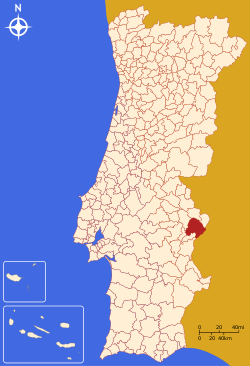Elvas, Portugal
| Elvas | |||
|---|---|---|---|
| Municipality | |||
 |
|||
|
|||
 |
|||
| Coordinates: 38°52′N 7°09′W / 38.867°N 7.150°WCoordinates: 38°52′N 7°09′W / 38.867°N 7.150°W | |||
| Country |
|
||
| Region | Alentejo | ||
| Subregion | Alto Alentejo | ||
| Intermunic. comm. | Alto Alentejo | ||
| District | Portalegre | ||
| Parishes | 7 | ||
| Government | |||
| • President | Dr. Nuno Miguel Fernandes Mocinha (PS) | ||
| Area | |||
| • Total | 631.29 km2 (243.74 sq mi) | ||
| Population (2011) | |||
| • Total | 23,078 | ||
| • Density | 37/km2 (95/sq mi) | ||
| Time zone | WET/WEST (UTC+0/+1) | ||
| Website | http://www.cm-elvas.pt | ||
Elvas (Portuguese pronunciation: [ˈɛɫvɐʃ]) is a Portuguese municipality, an episcopal city and frontier fortress of Portugal, located in the district of Portalegre in Alentejo. It is situated about 230 kilometres (140 mi) east of Lisbon, and about 15 kilometres (9.3 mi) west of the Spanish fortress of Badajoz, by the Madrid-Badajoz-Lisbon railway. The municipality population as of 2011[update] was 23,078, in an area of 631.29 square kilometres (243.74 sq mi). The city itself had a population of 16,640 as of 2011[update].
Elvas is among the finest examples of intensive usage of the trace italienne (star fort) in military architecture, and has been a World Heritage Site since 30 June 2012. The inscribed site name is Garrison Border Town of Elvas and its Fortifications.
Elvas lies on a hill 8 kilometres (5.0 mi) northwest of the Guadiana river. An aqueduct 6 kilometres (3.7 mi) long supplies the city with pure water; it was begun early in the 15th century and completed in 1622. For some distance it includes four tiers of superimposed arches, with a total height of 40 metres (130 ft). The surrounding lowlands are very fertile, and Elvas is known for its olives and plums, and exports the latter, either fresh or dried, in large quantities. Brandy is distilled and pottery manufactured in the city.
It was wrested from the Moors by Afonso I of Portugal in 1166 but was temporarily recaptured before its final occupation by the Portuguese in 1226. In 1570 it became an episcopal see, the Roman Catholic Diocese of Elvas, until 1818. Its late Gothic cathedral, which has also many traces of Moorish influence in its architecture, dates from the reign of Manuel I of Portugal (1495–1521).
...
Wikipedia


